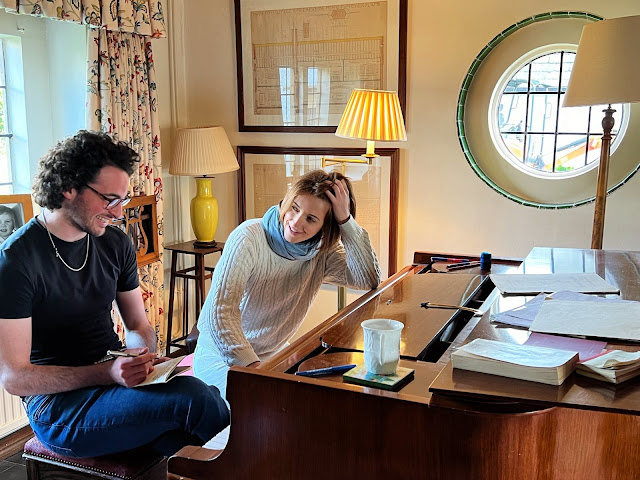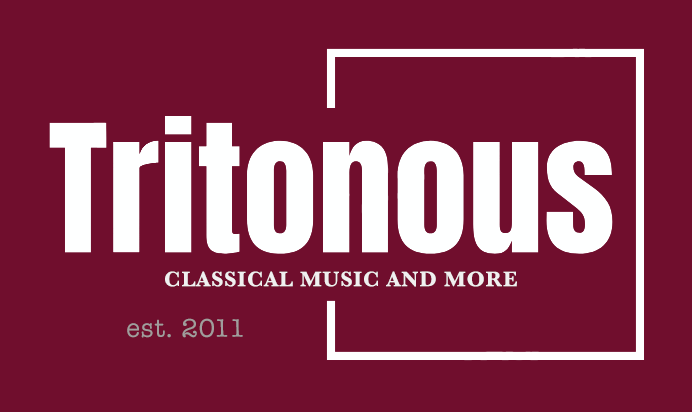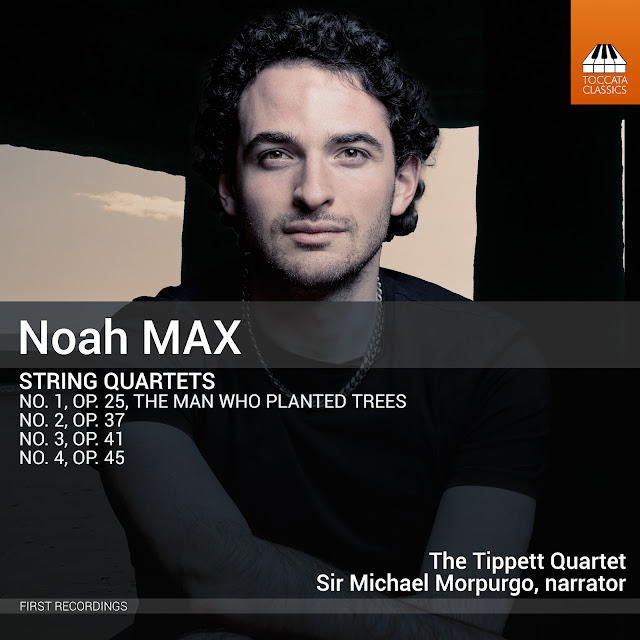 |
| Noah Max (Photo: Richard Ecclestone) |
Last month, Toccata Classics released a disc of the four string quartets by the young British composer Noah Max [see details] recorded by the Tippett Quartet (John Mills, Jeremy Isaac, Lydia Lowndes-Northcott, Bozidar Vukotic). This group premiered Noah’s String Quartet No. 2 at the Thaxted Festival in 2023, where Noah was composer in residence [see my review]. This is the second disc of Noah’s music on Toccata, the first Songs of Loneliness being a disc of varied solos and chamber music [see my review].
The four quartets were all written over quite a short period, yet are remarkably diverse. The first quartet from 2020 is linked to the fable The Man Who Planted Trees written in 1953 by French writer Jean Giono (1895-1970), narrated on the disc by Sir Michael Morpurgo. In three movements, the music is tonal and atmospheric, supplementing the narrative and the work interweaves text and music, sometimes keeping them independent and sometimes as melodrama. The result slows down the narrative somewhat but creates a striking synthesis. The work is ultimately positive, Morpurgo’s last words are ‘in spite of everything, humanity is admirable‘, and it forms a strong contrast with Noah’s fourth quartet.
 |
| The Escape Ladder, 1940 by Joan Miró |
The second quartet, from 2021, was inspired by a painting by Joan Miró, The Ladder of Escape, and sculptures by Henry Moore and Barbara Hepworth. Like the first quartet, it is in three highly contrasting movement. The first ‘Andante glaciale’ bleak and intense with edgy harmonies, the second, ‘Intensamente con ira’ moving between frantic scurrying and almost stasis yet with an intense, almost angry and hard won climax, followed by a final movement, ‘Unearthly; mesmeric’ that seems almost haunted.
The third quartet dates from 2022 and was commissioned by the Brompton Quartet who gave the premiere at Conway Hall. In a single, ten-minute movement it is intense, densely woven counterpoint with tightly wound line and expressionist motifs all in closely worked argument.
The fourth quartet from 2023 is intimately linked to Noah’s opera, The Child in Striped Pyjamas [see my review], a work that treats the Holocaust directly. The quartet is in a single fifteen minute movement, uneasy, intense and dramatic, the material restless and ultimately uncomfortable.
When I asked Noah why string quartets, he explained that playing string quartets was how he fell in love with music, describing them as his first love. (Noah grew up in a musical household, his parents are the cellist Robert Max and pianist Zoë Solomon). As a young cellist, though he played in orchestras, what he really enjoyed was playing quartets and felt it was how he came into contact with other musicians. Besides, the bass line of a Haydn quartet was a universe unto itself, the bedrock of a palace, and he felt connected to the music in a way that he had not felt before. Playing quartets made him think about how music is put together, and after that first exposure, his love developed and deepened. He worked his way through the core quartet repertoire, into more extended techniques, learning how to build interesting textures, and unlike anything before, creating a series of lines of musical enquiry that still retained links to canonic works.
He feels that string quartets no longer form the backbone of composers’ oeuvres the way they used to do, and he would like to try to keep quartet writing as a significant part of his output. The quartets on the new album are four of his strongest pieces and he feels close to them.
The four string quartets are all strikingly different and Noah admits that each time he writes a new piece there is a natural reaction against the work before. He spends time doing one thing, so inevitably the next brings about a reaction. But, that said, he feels that they are still unified, that he is finding his own voice. He sees the works as the result of a youthful imagination searching for possibilities. The four have a common harmonic language, including the thorny, micro-tonal third quartet, and he reflects that all his works, no matter how varied, have a particular harmonic stamp.
The external influences in these works arise partly because when writing so much gets folded into the music. From a young age, he was exposed to visual arts as well as music, so it is perhaps inevitable that his second quartet takes visual clues as its inspiration. But then he admits that he does not really know what goes into each piece, and there are inevitably different influences. He finds it interesting to look back, contrasting with how he sees the works now, and hearing them more in performance means he gets to know the pieces differently. Ultimately, he finds inspiration a bit of a mystery – scary but liberating.
The first quartet, inspired by Jean Giono’s fable, interlinks music and narration and I wondered what it would be like without the narration, and in fact, the work was recorded like that with the narration added later. He feels that the piece ‘came from a strange place’ but he is fond of it and has not written anything else like it. He is interested in the extent to which you could divorce the music from the text or even give the music a new context and he would love to try this, adding that it would only add to the richness of the thing.
For the second quartet, he hopes that you do not need to be familiar with Miro’s painting to appreciate the work, but the music is distinctly an expression of what Miro and the works by Moore and Hepworth mean to him. And he adds that anyone who has not encountered Miro’s paintings certainly should find a way to encounter them and that his first encounter stunned him and made him want to write music.
Will there be another quartet, I wondered? And indeed, he has already started work on a new one, but he deliberately left a gap and it is a little over two years since he wrote the fourth quartet. His life has changed since then, he has written a lot and feels that he does have something else to say, adding that the work will have commonality with the previous quartets. You only have to look at the number of quartets that other composers have written (Haydn wrote 68, Shostakovich wrote 15) to realise that it is an inexhaustible genre. One that is in the forefront of his mind.
Looking ahead, he comments that he feels the same as the artist Maggi Hambling, that it is bad luck to talk about projects until they are complete. He does admit to having an exciting project for Ian Bostridge in the works, and that when we spoke he was dead in the centre of a Kaddish for strings and chorus. This is intended to be a memorial prayer for victims of Kristallnacht (the pogrom against Jews carried out by members of the Nazi party in November 1938). This will be the third of Noah’s works (with The Child in the Striped Pyjamas and the fourth string quartet) linked by a common thread of the Holocaust. He has spent a lot of time exploring that particular part of the human psyche and feels that there will come a time when he wishes to explore other dark corners.
 |
| Noah Max and Alexandra Balog |
In May he will be in New York, where pianist Alexandra Balog will be premiering his new Piano Sonata No. II: The Curve at Carnegie Hall, though he has not quite got his head around that one yet, the event has not quite hit him.
Noah Max: String Quartets: No. 1, The Man Who Planted Trees, Op. 25; No. 2, Op. 37; No. 3, Op. 41; No. 4, Op. 45
Sir Michael Morpurgo, narrator, The Tippett Quartet (John Mills and Jeremy Isaac, violins, Lydia Lowndes-Northcott, viola, Božidar Vukotić, cello) – Toccata TOCC 0749
The blog is free, but I’d be delighted if you were to show your appreciation by buying me a coffee.
Elsewhere on this blog
- Youthful impulse and power: Mozart’s Requiem from National Youth Choir, Sinfonia Smith Square and Nicholas Chalmers – concert review
- Looking at these modern classics anew: Britten’s Canticles at the Barbican with James Way, Natalie Burch & friends – concert review
- This production, will undoubtedly be remembered for years to come: Massenet’s Werther in Paris with Marina Viotti, Benjamin Bernheim & Marc Leroy-Calatayud conducting Les Siècles – opera review
- Compelling & magisterial: Sunwook Kim directs Chamber Orchestra of Europe from the piano in Beethoven’s 3rd & 4th piano concertos – review
- Letter from Florida: Mozart, Verdi, Rossini, Leoncavallo & Mascagni at Sarasota Opera’s Winter Festival – opera review
- An incredible feeling when you get it right; Martin Owen on performing Mozart’s complete horn concertos with Manchester Camerata – interview
- A somewhat eclectic yet satisfying journey: Swiss baritone Äneas Humm explores ideas of freedom in songs by Beethoven, Schubert, Amy Beach, and Joseph Marx – record review
- Remarkable intensity: powerful new 1980s-set Peter Grimes from Melly Still at Welsh National Opera with Nicky Spence – opera review
- Telling a musical story: violinist James Ehnes on the challenges of recording of Bach’s violin concertos with Canada’s NAC Orchestra – interview
- Powerful stuff: Ukrainian composer Boris Lyatoshynsky’s dramatic war-inspired symphony alongside Prokofiev’s Semyon Kotko – concert review
- Home










